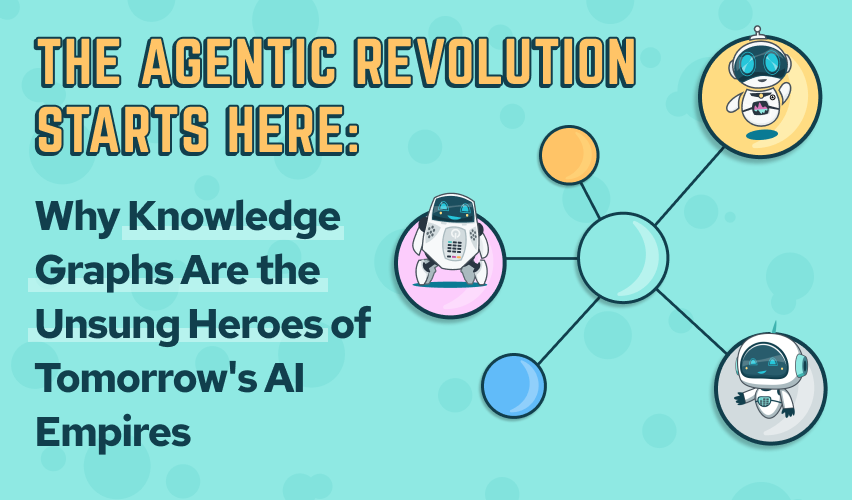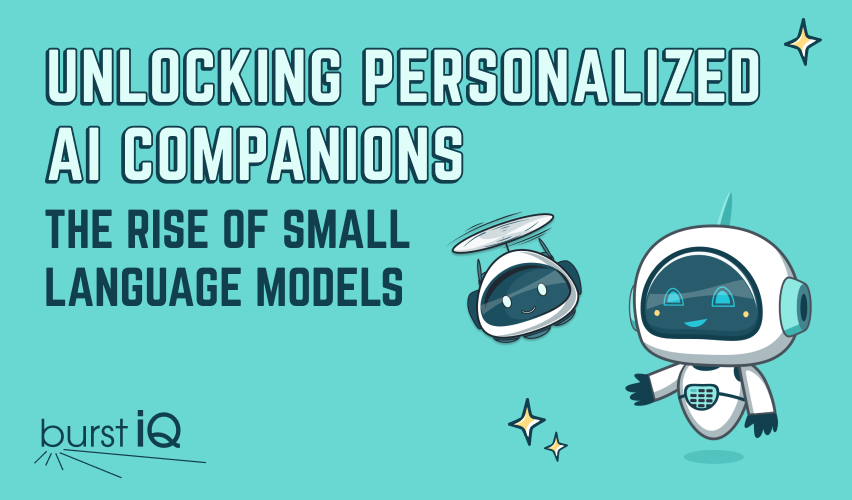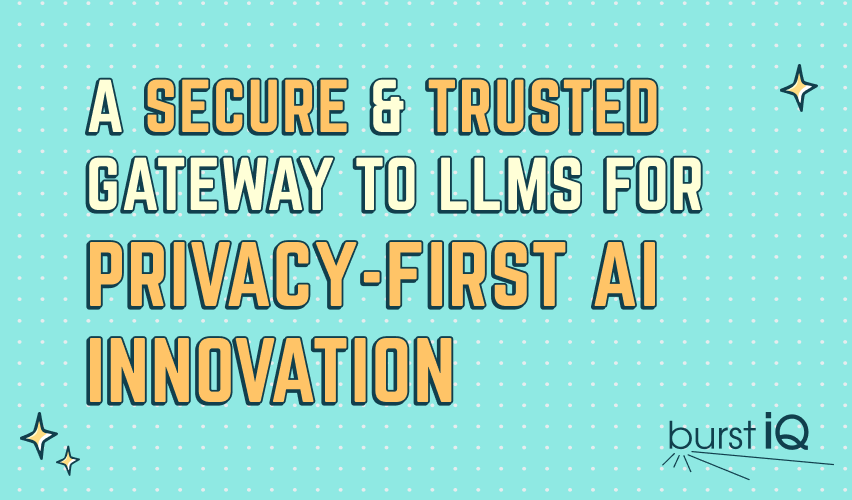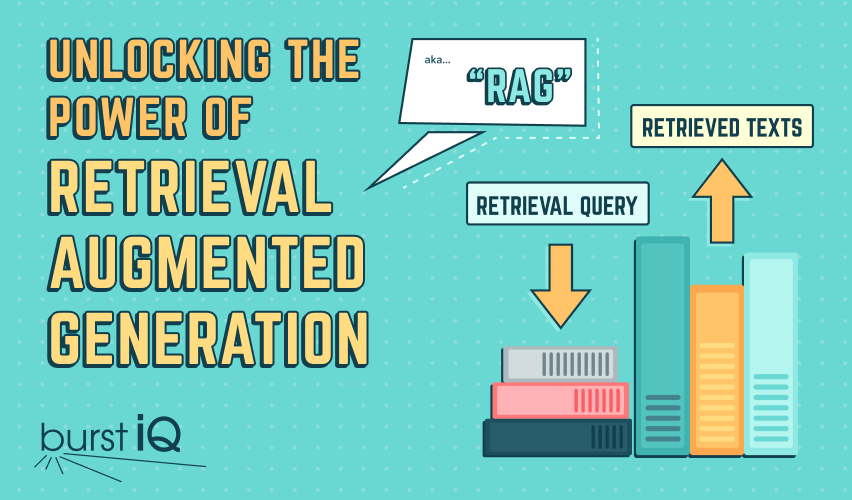The Evolution of Data Governance:
Building Trusted Data Ecosystems
By Frank Ricotta, CEO & Founder, BurstIQ
Data governance has traditionally been defined as the framework of policies, roles, responsibilities, and processes that ensure the effective management of an organization’s data assets. It focuses on data quality, security, privacy, accessibility, and compliance with regulatory requirements.
“The 2024 Gartner CDAO Agenda Survey shows that CDAOs increasingly recognize the criticality of governance for D&A success, with 89% of respondents saying D&A governance is essential for enabling business and technology innovation. Investment in improving D&A governance maturity, therefore, enables better business results. Gartner analysis shows that organizations that go from low to high maturity in setting, enforcing and communicating governance strategy see a 21% increase in overall financial performance.”1
However, establishing a sustainable data governance structure has been elusive for many organizations. Additionally, the new demands of AI and the need to build distributed data ecosystems have made traditional centralized data management initiatives ineffective and obsolete. New solutions must balance the need to establish central policies with the ability to decentralize and democratize data access while still managing and enforcing these policies in real-time.
The new data governance objectives must address the distributed nature and the reality that we live in a data-abundance world, not a data-scarcity world. Data governance must be designed to meet the demands of modern organizations, which require more than just data protection and control.
Key Capabilities of a Modern Data Governance Capability Include:
Unify and Democratize Data:
Data governance today must create unified data landscapes that break down silos vs simply dumping data into cloud data warehouses. By democratizing access to data, organizations can empower employees at every level to make data-driven decisions. The goal is to push data access to the individuals and organizational functions that need it in an on-demand fashion. Essentially, access is removed from the hands of a select few database administrators (DBAs) in an organization that only has technical data knowledge and may not have the institutional or business knowledge required for access rights.
Enable Collaboration:
Modern governance frameworks must facilitate cross-departmental collaboration by ensuring data is accessible, secure, and shared according to governance policies. The policies need to be enforced and go beyond being a paper tiger. This requires that the data and frameworks around the data have the inherent capability to enforce organization policy, access, and consent without human intervention or demonstrating that it happened after the fact.
Improve Data Quality:
Data quality is high on the list for all data professionals and AI solutions. Ensuring the accuracy, consistency, and timeliness of data is vital for making informed decisions. A core objective is maintaining high-quality, trustworthy data at every stage of its lifecycle. This means tracking data lineage, data custody, and data providence regardless of where the data resides or originated. By taking this alternative approach, rather than working to cleanse the data at ingest, the data governance mechanisms do so as data is utilized and transformed. There is something to be said that all data has value and attributes that enable learning and insights, even insufficient data.
Capture Institutional Knowledge:
Governance systems should capture and document the organization’s tacit knowledge, embedding it within the data itself to ensure institutional wisdom is preserved and utilized. Active metadata has become a popular term of art to describe the methods used to do this.
Leverage Intelligence:
AI and machine learning are transforming how businesses use data. Modern data governance must support the use of intelligence to automate workflows, improve decision-making, and innovate with data at scale. This means that modern data governance solutions must employ AI as part of the system itself and not just treat it as a data consumer.
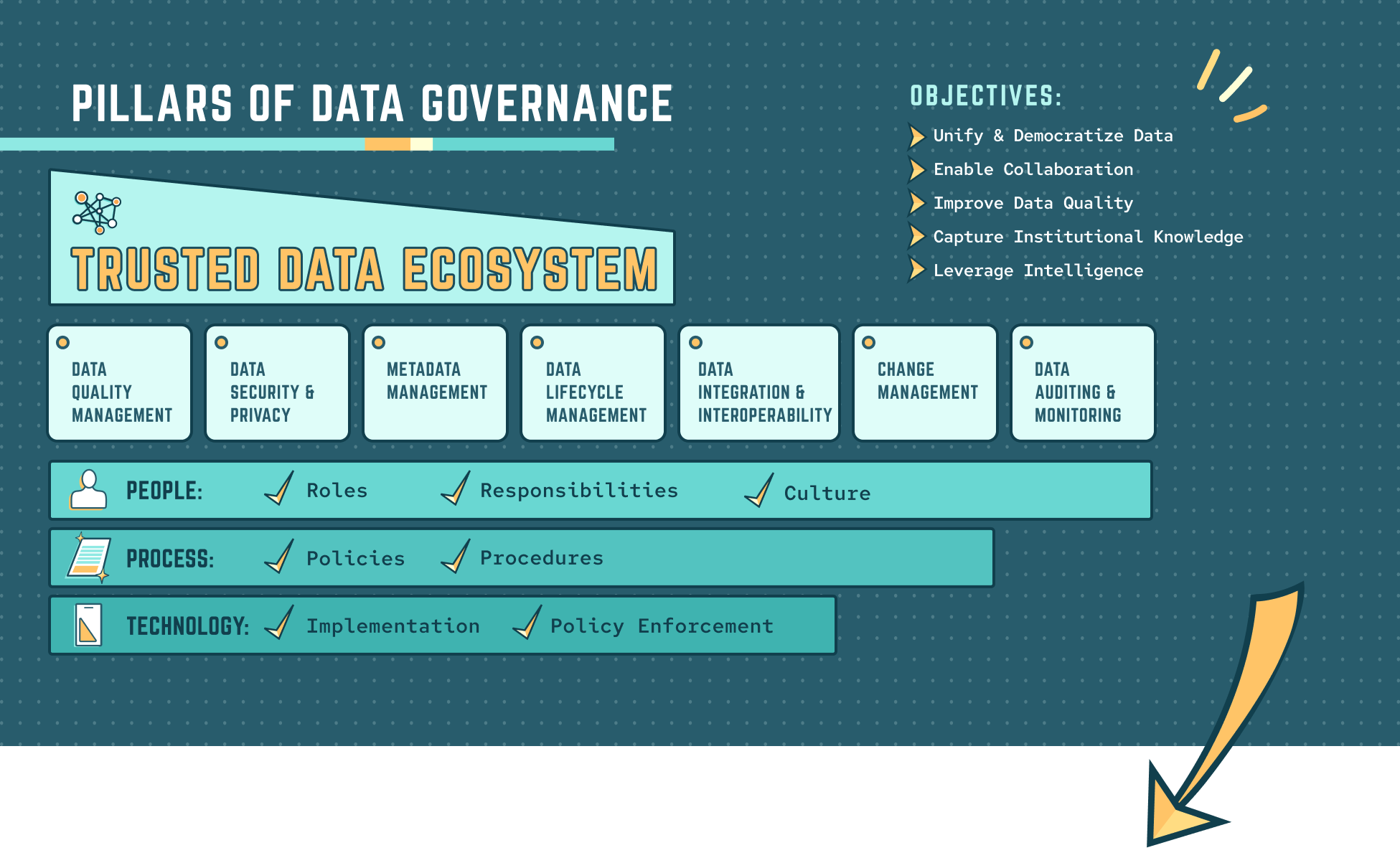
Critical Attributes of Modern Data Governance
To achieve these objectives, modern data governance must be supported by several critical attributes. Many of the concepts are consistent with the legacy goals of data governance. In reality, it is more about how they are deployed as active components of the solution.
Data Quality Management:
Processes and tools that ensure data is accurate, complete, and consistent across the organization. Regular data validation and cleansing routines maintain the integrity of data. AI and ML can be trained and leveraged to monitor the overall data quality of information, detect anomalies, and drift from human-known or AI-determined normal.
Data Security & Privacy:
Strong governance frameworks incorporate security measures like encryption, access controls, and regulatory compliance. This ensures data is protected from unauthorized access and meets legal privacy standards. Data security must also extend to the data itself and consent rules within the system, not just as an access barrier.
Metadata Management:
Effective governance requires tracking and managing metadata—data about the data itself. Metadata provides context, making data easier to find, understand, and use. This also needs to be extended to active metadata, which includes transactional histories, context, trust, and many other attributes that extend beyond current stand-alone static metadata management solutions.
Data Integration & Interoperability:
Data governance must support seamless integration across platforms, databases, and systems. This ensures data can flow and be used across different environments while maintaining governance standards. These solutions need to extend beyond point-to-point integration methods and drive to dynamic common canonical models. This allows the data infrastructure to expand beyond its own and control boundaries with the ability to integrate new sources and consumers of data. This is foundational to data ecosystems.
Change Management:
Governance frameworks must include processes for handling data-related changes, including updates to data models, policies, or technology infrastructure. A formal change management process reduces risks during transitions. However, organizations don’t have the resources and time to do this in a bureaucratic fashion. Thus, the need for an AI intermediary and the ability to use different structures, such as graph structures, as the foundational basis for the canonical models.
Data Auditing & Monitoring:
Continuous monitoring and auditing of data processes ensure governance compliance and data accuracy over time. This helps organizations catch issues like security breaches or data inaccuracies early.
The Importance of People, Process, and Technology
Data governance framework can only succeed by focusing on three core elements: people, process, and technology.
People:
Data governance requires clearly defined roles and responsibilities. Data stewards, owners, producers, customers, and custodians must work together to ensure data is appropriately managed and used. Beyond roles, governance success depends on fostering a data-driven culture where employees understand the value of data and their responsibility in managing it.
Process:
Governance relies on well-established policies and procedures to guide how data is handled. From data classification and access controls to incident response plans, well-defined processes ensure data is secure, compliant, and ready for use across the enterprise.
Technology:
Finally, technology is the enabler that brings data governance to life. Breaking away from traditional RDBMS siloed data solutions, automated data quality tools, security platforms, and AI-powered data governance solutions will streamline the process, ensuring consistency and scalability.
Building Trusted Data Ecosystems Beyond Enterprise Boundaries
Today’s organizations increasingly rely on data that crosses enterprise boundaries, flowing between partners, vendors, and customers.
To build trusted data ecosystems in this interconnected environment, modern data governance must:
Ensure data interoperability across systems so information flows seamlessly while maintaining security and privacy controls.
Implement consistent governance standards that all partners adhere to, ensuring the data exchanged is trustworthy and secure.
Facilitate collaboration across different entities while maintaining clear ownership and responsibility for shared data.
These ecosystems are crucial for driving innovation and agility, but they can only succeed with solid governance frameworks that establish trust and accountability across organizational boundaries.
Why LifeGraph from BurstIQ is the Answer
BurstIQ’s LifeGraph® platform is the ultimate solution for modern data governance, offering the tools needed to build trusted data ecosystems that scale across industries.
Here’s why LifeGraph is the key:
Blockchain-Backed Trust:
LifeGraph’s blockchain architecture creates an immutable record of every data interaction, providing transparency and ensuring data authenticity. This trust layer is critical for building governance systems that cross enterprise boundaries.
Privacy-Enhanced Data Exchange:
LifeGraph’s privacy-preserving infrastructure enables organizations to securely share data across partners while maintaining control over who accesses what information. This ensures compliance with global privacy regulations.
AI-Ready Governance:
With built-in AI and machine learning capabilities, LifeGraph continuously manages data quality, lifecycle, and metadata, making it easy for organizations to govern data while maximizing its use for advanced analytics.
Scalability Across Ecosystems:
LifeGraph’s flexible, scalable framework supports enterprises’ governance needs, allowing data to flow seamlessly across systems and geographies while maintaining compliance.
Web3 Data Fabric and Knowledge Graphs:
LifeGraph’s Web3 data fabric enables interoperability and real-time access to decentralized data sources while enhancing security through blockchain technology. Knowledge graphs provide structured insights by mapping relationships within data, improving data quality, and facilitating collaboration across teams. Together, these elements establish a decentralized, adaptable, and compliant data governance framework that empowers organizations to navigate the complexities of governance.
In today’s fast-moving, data-driven landscape, organizations need more than traditional governance frameworks—they need a platform like LifeGraph that can unify, secure, and democratize data while enabling collaboration and innovation at scale.
In conclusion, the evolution of data governance is crucial for modern organizations navigating the complexities of a data-abundant world. As traditional frameworks become outdated, there is a pressing need for innovative solutions that unify and democratize data, enhance collaboration, and maintain high data quality. BurstIQ’s LifeGraph platform emerges as a transformative solution, leveraging blockchain-backed trust, AI-ready governance, and a Web3 data fabric to create secure, scalable, and interoperable data ecosystems. By integrating knowledge graphs, LifeGraph ensures structured insights and seamless collaboration, empowering organizations to meet the demands of today’s dynamic data landscape. As businesses continue to expand beyond enterprise boundaries, embracing such advanced governance frameworks is essential for driving innovation, ensuring compliance, and fostering trusted data ecosystems.
Connect with us to find out how to take the first steps toward modern data governance.
ABOUT BURSTIQ:
LifeGraph® by BurstIQ transforms organizational data through advanced data management, privacy-enhancing technology, and knowledge graphs, creating a single, secure source of truth that eliminates silos and reveals hidden connections. This powerful platform facilitates easier analysis, insightful collaboration, and innovative decision-making while modernizing legacy data repositories. Additionally, LifeGraph enhances AI readiness by integrating machine intelligence with human insights, enabling organizations to develop hyper-personalized solutions and continuously train AI systems for adaptability. This synergy not only drives value but also empowers organizations to leverage their data as a strategic asset for sustained innovation and growth.


